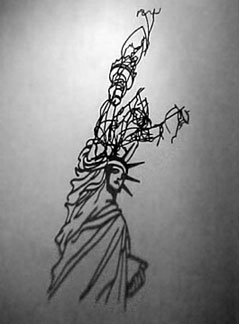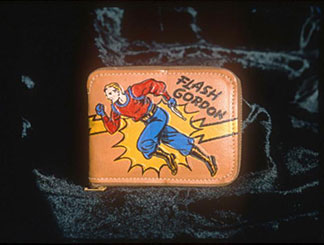 |
ROBERT BECHTLE
20th Street - Early Sunday Morning – 1997
oil on canvas
36 x 66 inches (91.44 x 167.64 cm)
Robert Bechtle I am interested in how things look; I am also interested in painting that is based upon how things look. I like to see things the way they are rather than thinking how they can be changed. The richness and range of the visual world constantly thrills and amazes me. I am most particularly interested in using the part of our world which we seem to notice least...that is, our everyday surroundings as we live day to day. Thus, I have painted friends and family, familiar houses, streets and neighborhoods. The paintings are on one level, about middle class American life as experienced in California. On another, they are about reconciling that subject matter with concerns about formal painting issues (the use of color and light, design, and the kinds of marks one must make to replicate appearances). They are, in that sense, a part of a long tradition of European and American painting which has sought to find significance in the details of the commonplace.
Robert Bechtle, 1999
 |
LARRY
KAGAN
Liberty – 2001
wire with shadow
69 x 26 x 19 inches (175.26 x 66.04 x 48.26 cm)
Larry Kagan Like most artists that I know of, I love to draw and I consider drawing to be a most spontaneous and expressive visual medium. My exploration of drawing with shadows however, has forced me to look much more deeply at drawing and the complex dimensional interactions that are responsible for both its immediacy and at the same time its wonderful ambiguity.
Drawing as an activity depends on a mapping process. It converts scattered and fragmented observations of three dimensional space into coherent two dimensional representations that attempt to capture a continuity that may exist physically, but which certainly does not exist cognitively. Our vision of the physical environment is an illusion foisted on us by the method by which we acquire and integrate visual data. We translate sequential dynamic experiences into static geometric structures, and we orient ourselves within those structures by means of visual clues. Shadows constitute one important family of such clues.
When we "see" we never focus on shadows. Rather, we use our peripheral vision to account for the presence of shadows, and we extrapolate from them all kinds of information about size, scale, proximity, illumination, time of day, spatial and atmospheric conditions and the like. We are generally unaware of this seeing process unless something goes awry. For example, we might be startled not to see a shadow under a car, because that is usually how we tell that it is touching the road surface. The absence of a shadow would alert us that something is wrong. My shadow drawings are in fact wrong shadows, and it is precisely that "wrongness" that makes them at once so puzzling and so involving. They violate everything that we know about shadows.
Simply put, I draw by creating structures that cast inappropriate shadows. The normal expectation, that a particular structural shape will create an analogous shadow does not happen in my work. Rather, shadows appear that seem to be totally unrelated to the structures that produce them, causing viewers to doubt their existence. In fact viewers will swear that what seem to be shadow forms are actually cleverly drawn or painted forms on the wall. And when they discover that they are in fact looking at shadows, there usually ensue protracted investigations into which pieces of the structure are responsible for casting particular lines and forms in the drawing.
What I have discovered is that it is possible to create a visual dissonance between object and shadow that opens up an entirely new creative space. And what is more, because it was there all along to be seen and yet was not, we are left to wonder what else we may be missing.
. Larry Kagan, March 2001
Back
To Previous Exhibitions
 |
GREG CONSTANTINE
Vincent In Smoke - 1999
acrylic on canvas & wood
25 x 37 x 2 inches (83.82 x 167.64 cm)
Greg Constantine Beginning in 1985 my work has dealt with sections of elaborate picture frames that are attached to fragments of famous paintings. These early "slices of art" have a strange angular presence, but the partial image is eminently recognizable and familiar. Through several permutations within eight years, the fragments evolved into half of a self-portrait of a famous artist (Picasso, Rembrandt, Ingres, Botticelli) combined with the opposite half face of a familiar female subject (a demoiselle, girl at a open half-door, an Odalisque, and Venus, respectively.)
While the distinction between the two halves is obvious due to the difficulty of perfect alignment or coloration, the viewer's brain, and not the eye, resolves those differences. It should be noted that the two differences mentioned are deliberate in order to avoid a seamless combine. Despite the irony of the combined image, the resultant face maintains the attributes and especially the identity of each of the component halves. My doctor has called this brain/eye phenomenon "Messing with the Corpus Callosum" (involving the heightened activity between the left and right lobes of the brain which is facilitated by the connector called the Corpus Callosum). A subsequent series of works combined half of a famous artist's self portrait along with a black and white half face of the Hollywood actor who portrayed the artist in a motion picture. (Vincent van Gogh with Kirk Douglas; Paul Gauguin with Anthony Quinn; Rembrandt with Charles Laughton; and Picasso with Anthony Hopkins).
Most recently my work consists of images of half of a Vincent van Gogh self portrait combined with a painted half face from a black and white photograph of Van Gogh. Vincent created forty-five self-portraits revealing various states of mind and emotion while there are only three existing photographs of Van Gogh at different ages. Part of my intent in combining these photographs with self-portraits is to present what might be considered Vincent's expressive distortions. Or, on the other hand, to reveal his ability to accurately represent his true appearance.
"Vincent and Me" and "Vincent and Me II " have a black and white portion of myself grafted into a Van Gogh self-portrait. My intent here was to not only extend the phenomenon of resolving two vastly different half faces when joined, but also to acknowledge my attachment to Vincent as one of my artistic ancestors.
Greg Constantine, March 2001
Back
To Previous Exhibitions
 |
CARSON
FOX
Rust Baby Dress - 2000
cotton, artificial hair, iron powder
9.5 x 16 inches (24.13 x 40.64 cm)
Carson Fox Over the past few years, I have focused my gaze upon the rather mundane objects of my youth, specifically items of clothing, to chart how they have shaped me into the person I am today. This investigation allows me to return to those items that nostalgically and sometimes painfully symbolize moments and feelings I have experienced over the course of my maturing life. In a broader sense, I am also concerned with how simple conventions of dress continue to influence the construction of female selfhood in Western contemporary society.
I regard the construction of identity and the fabrication of art objects as similar processes. Both are defined by multiple layers that are influenced by change, evolution, time, and deliberate manipulation. My work serves as a material artifact that attests to my existence. In the layers of the object a record exists which approximates experiences that are both remembered and located along the way.
The found garments I am working with include women's and girl's gloves, slips, underwear, and dresses. The objects are subjected to numerous methods that promote their partial disintegration. This includes the use of mud, dirt, sand, wax, artificial hair, tearing, staining, and burning. The artificial aging and destruction of these objects is intended to correspond with the inevitable decay and dissolution of the memories and experiences they represent. The corporeal garments remain as a souvenir of a past history either real or imagined.
Carson Fox, March 2001
Leonard Schneir Wallet Collecting In over 30 years of being a collector I have never seen an article written about pop culture wallets nor have I met another wallet collector. In fact there is almost no information available about wallet collecting, there are no books, price guides or clubs. But I enjoy collecting memorabilia that few if any other people collect. There are many advantages to this, namely you are often able to find a bargain and if lucky, might even create a market that other collectors will follow.
I am a child of the 1940's and 1950's and most of my wallets are from these two decades. Among my favorites are Elvis Presley, Captain Video, Buck Rogers, Superman, Roy Rogers, Gene Autry, Hop Along Cassidy, The Lone Ranger, Zorro, Blondie, Paladin, Red Ryder and Lassie. Almost all are the standard wallet size of about 3.25 inches by 4.25 inches and are faux leather as they were made for children.Their original price rarely exceeded 25 cents, today these same wallets sell for between $25.00 and $500.00.
Leonard Schneir, March 2001
This web site was designed and created by REDRUM DESIGNS ©2001 OK HARRIS All Rights Reserved
